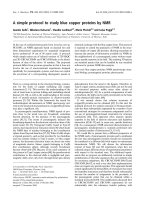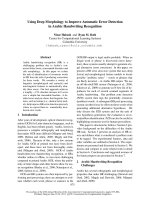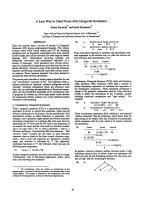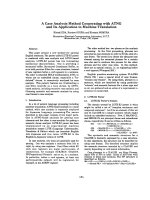Báo cáo khoa hoc:" A simple way to distinguish bed clothing contamination in a whole body bone scan: a case report" ppsx
Bạn đang xem bản rút gọn của tài liệu. Xem và tải ngay bản đầy đủ của tài liệu tại đây (280.48 KB, 4 trang )
BioMed Central
Page 1 of 4
(page number not for citation purposes)
Journal of Medical Case Reports
Open Access
Case report
A simple way to distinguish bed clothing contamination in a whole
body bone scan: a case report
Majid Assadi*
1
, Abdolali Ebrahimi
1
, Mohammad Eftekhari
2
, Armaghan Fard-
Esfahani
2
, Mojgan Nazar Ahari
2
, Iraj Nabipour
1
, Farshid Gheisari
3
,
Shabnam Shahbaz
3
, Reza Baghaei
2
and Sakineh Assadi
1
Address:
1
Department of Nuclear Medicine and Oncology, The Persian Gulf Health Research Center, Busheher University of Medical Sciences,
Bushehr, Iran,
2
Research Institute for Nuclear Medicine, Shariati Hospital, Tehran University of Medical Sciences, Tehran, Iran and
3
Nuclear
medicine department, Namazi Hospital, Shiraz University of Medical Sciences, Shiraz, Iran
Email: Majid Assadi* - ; Abdolali Ebrahimi - ;
Mohammad Eftekhari - ; Armaghan Fard-Esfahani - ;
Mojgan Nazar Ahari - ; Iraj Nabipour - ; Farshid Gheisari - ;
Shabnam Shahbaz - ; Reza Baghaei - ; Sakineh Assadi -
* Corresponding author
Abstract
Whole body bone scan with Technetium-99m MDP (methylene diphosphate) can detect bony
lesions due to altered osteoblastic activity.
Non-physiologic or increased radiotracer uptake in the bony structures of patients with a history
of malignant diseases is usually interpreted as being suspicious of bone metastasis. It is extremely
important to properly distinguish false positive sites of Tc-99m MDP localization. We present three
patients with the same pattern of Tc-99m MDP abnormality in different locations. These scans
were all performed on the same day to evaluate possible bone metastases in three patients with
breast carcinoma. After careful examination, repeated images revealed bed clothing contamination.
This is different from bed contamination by displacement among different patients. It is also
different from detector contamination by limited area of involvement where detector
contamination appears as a line throughout the total body projection. It can be helpful if a nuclear
medicine specialist has a brief look at all scans prior to reporting them. In cases where the same
pattern of abnormality is repeated in all images, the possibility of technical error such as bed
clothing contamination rather than a pathological abnormality should be borne in mind.
Introduction
Whole body imaging with Tc-99m MDP is able to detect
bone metastasis. After administration of Tc-99m MDP
physiologic activity is noted in a fairly homogeneous pat-
tern in bony structures, and this is generally symmetrical.
Urinary bladder and kidneys are visualized as normal
findings [1]. However, on some occasions, increased
activity in the bony or extra-skeletal structures is not due
to bone-related pathologies. Contamination is one of the
most important causes [1]. We describe three patients
with the same pattern of Tc-99m MDP contamination
occurring in different places. All of the scans were per-
formed on a same day in patients to exclude possible bone
metastasis from breast carcinoma.
Published: 5 December 2007
Journal of Medical Case Reports 2007, 1:173 doi:10.1186/1752-1947-1-173
Received: 18 July 2007
Accepted: 5 December 2007
This article is available from: />© 2007 Assadi et al; licensee BioMed Central Ltd.
This is an Open Access article distributed under the terms of the Creative Commons Attribution License ( />),
which permits unrestricted use, distribution, and reproduction in any medium, provided the original work is properly cited.
Journal of Medical Case Reports 2007, 1:173 />Page 2 of 4
(page number not for citation purposes)
Case Presentation
Case-1
A 35 year old woman was referred to our center for a
whole body bone scan to exclude possible bone metasta-
sis. She had breast cancer and had undergone right mas-
tectomy 17 days ago. She had received no radiotherapy or
chemotherapy and she had no complaints of bone pain.
The posterior image showed a linear activity in the left
lower chest (fig 1). Careful observation showed no abnor-
mality on the anterior projection. The possibility of con-
tamination was considered. After changing her bed
clothing, the abnormal tracer uptake disappeared.
Case-2
A 45 year old woman, with a history of adenocarcinoma
of the right breast and a mastectomy performed two years
ago, was referred for whole body bone scan. Again there
was a linear pattern of activity in the posterior view of the
left lower chest (fig 2). The image showed no activity in
that region after changing the bed clothing.
Case-3
A 43 year old woman, who had undergone left mastec-
tomy four years ago, was referred to our center for a fol-
low-up bone scan. On posterior projection there was
abnormal activity with linear pattern in the left shoulder
region (fig 3). After removing the bed clothing, the focal
activity was not visualized in repeat images.
Discussion
Tc-99m MDP whole body scan is a valuable procedure for
detecting bone metastasis; however the possibility of false
positive results due to technical error or contamination
should always be kept in mind. This is particularly true for
lesions seen only on a single view [2]. A common source
of contamination results from the intravenous injection
of the radioisotope. Contamination may result from
injection site dose infiltration, a leaking intravenous tube,
or from bleeding from the puncture site because of inade-
quate hemostasis [3]. Also, urinary contamination is a rel-
atively common finding in whole body bone scan (WBBS)
[3].
Sometimes the body or clothing contaminants migrate
through perspiration-soaked areas, typically the knees and
forearms, contaminating a protective cloth or table, which
may result in confounded and misinterpreted final images
[2]. Some reports also indicate adverse working condi-
tions, including hot and humid or cramped working envi-
ronments, can cause contamination [2]. There are several
methods to control these factors. For example, decontam-
inating different anatomical sites on the body, to elimi-
nate or reduce the uptake of radioactivity absorbed into
the body, and cleaning and decontaminating dry and wet
surface, equipment and clothing.
We observed a similar pattern of abnormality in different
places in three referred patients. We considered the possi-
bility of technical error as an explanation for these find-
ings. After careful examination and multiple spot views,
bed clothing contamination was confirmed as the cause of
these abnormalities. Clothing contamination differs from
Posterior whole body bone scan shows linear increased activity at the region of the left lower ribs due to bed cloth-ing contaminationFigure 1
Posterior whole body bone scan shows linear increased
activity at the region of the left lower ribs due to bed cloth-
ing contamination.
Journal of Medical Case Reports 2007, 1:173 />Page 3 of 4
(page number not for citation purposes)
bed contamination due to the observation of changeable
locations in different patients. It is also different from
detector contamination by its limited area of involvement
since detector contamination appears as a line throughout
the whole body on the total body projection [2].
Conclusion
Our findings suggest that if on brief review of images per-
formed on a same day, the same abnormal pattern of
activity is found in different bone scans, technical errors
or contaminations rather than actual bone abnormalities
should be the first consideration.
Whole body bone scan on posterior view depicts a linear pattern of increased tracer accumulation at the level of the left lower ribs due to bed clothing contaminationFigure 2
Whole body bone scan on posterior view depicts a linear
pattern of increased tracer accumulation at the level of the
left lower ribs due to bed clothing contamination.
This figure shows linear activity in the left shoulder region which is due to bed clothing contamination and which resolved after removing contaminated bed clothesFigure 3
This figure shows linear activity in the left shoulder region
which is due to bed clothing contamination and which
resolved after removing contaminated bed clothes.
Publish with BioMed Central and every
scientist can read your work free of charge
"BioMed Central will be the most significant development for
disseminating the results of biomedical research in our lifetime."
Sir Paul Nurse, Cancer Research UK
Your research papers will be:
available free of charge to the entire biomedical community
peer reviewed and published immediately upon acceptance
cited in PubMed and archived on PubMed Central
yours — you keep the copyright
Submit your manuscript here:
/>BioMedcentral
Journal of Medical Case Reports 2007, 1:173 />Page 4 of 4
(page number not for citation purposes)
List of abbreviations used
Methylene diphosphate (MDP), whole body bone scan
(WBBS)
Competing interests
The author(s) declare that they have no competing inter-
ests.
Authors' contributions
MA participated in its design and coordination and
helped to draft the manuscript and provided interpreta-
tion of the scintigraphic figures. AE revised the article for
intellectual content details and helped to draft the manu-
script. ME, AFE, MNA, IN, FG, S S, RB, SA supervised the
acquisition process and interpreted the scintigraphic
images. All authors read and approved the final manu-
script.
Consent
Written informed consent was obtained from all three
patients for publication of this case report and any accom-
panying images. Copies of these written consents are
available for review by the Editor-in-Chief of this journal.
Acknowledgements
We are indebted to the technologists at our department for data acquisi-
tion and other technical support.
References
1. Eggli DF, Tulchinsky M: Normal planar bone scan. In Skeletal
nuclear medicine Edited by: Collier BD, Fogelman I, Rosenthall L.
Mosby, USA; 1996:25-26.
2. Mosman Elton A, Peterson Luke J, Hung Joseph C, Gibbons Raymond
J: Practical Method for Reducing Radioactive Contamination
Incidents in the Nuclear Cardiology Laboratory. J Nucl Med
Technol 1999, 27:287-289.
3. Kasner DL, Spieth ME: The day of contamination. J Nucl Med
Technol 2003, 31(1):21-4.









